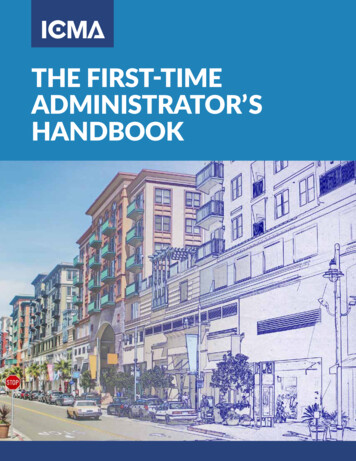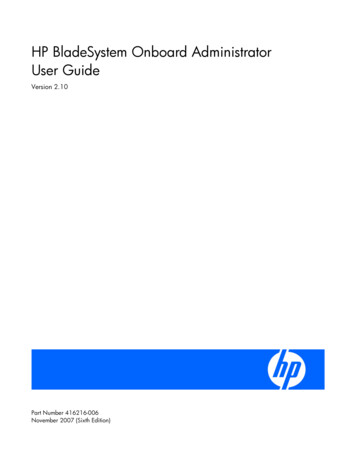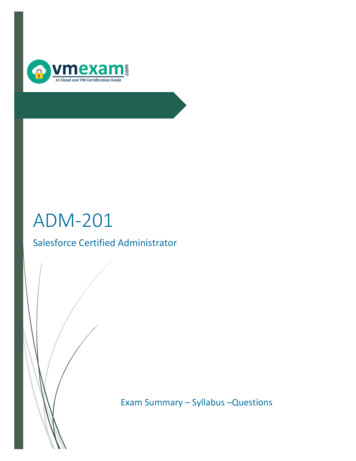
Transcription
THE FIRST-TIMEADMINISTRATOR’SHANDBOOK
ABOUT ICMAICMA, the International City/County Management Association, advances professional local government throughleadership, management, innovation, and ethics. ICMA provides member support; publications; data and information;peer and results-oriented assistance; and training and professional development to more than 13,000 city, town, andcounty experts and other individuals and organizations throughout the world. The management decisions made byICMA’s members affect millions of individuals living in thousands of communities, from small villages and towns tolarge metropolitan areas.Copyright 2020 International City/County Management Association, 777 North Capitol Street, N.E., Suite500, Washington, D.C. 20002. All rights reserved, including rights of reproduction and use in any form or by anymeans, including the making of copies by any photographic process or by any electronic or mechanical device,printed or written or oral, or recording for sound or visual reproduction, or for use in any knowledge or retrievalsystem or device, unless permission in writing is obtained from the copyright owner.Item number: e-44140To locate other ICMA Career Resources digital publications, please visit icma.org/career-resource-guides.
PREFACEIn 1998, the ICMA Executive Board and President Gary Gwyn appointed twenty-five membersto serve on the First-Time Administrator’s Task Force. They were asked to draft a document thatwould be beneficial to individuals who were about to serve or were already serving in their firstadministrator position or as the first administrator/manager for a local government.The initial First-Time Administrator’s Handbook was published in 2000. While it served as a valuablereference tool for countless ICMA members, after nearly ten years the ICMA Executive Board andPresident Darnell Earley appointed a twelve-member task force to review the Handbook in 2009.That task force updated the content and format, which served well for another decade.In 2018, President Karen Pinkos appointed the third task force, whose members are listed on pageii, to refresh the content of this valuable resource. In keeping with the times and the state of theprofession, this Task Force has made a number of further changes to the content and format ofthis guide and has worked to make the content more available to our profession, including: Paring down the content of the written guidebook and creating extensive web-basedresources Linking the content to other ICMA resources and indexing it by “depth levels” corresponding toadministrators’ needs and available time Emphasizing the questions that administrators need to ask and the stories of others ratherthan simply offering prescriptive advice Recommending to the ICMA Executive Board that this guide be considered an importantresource for the future of the profession and not simply a benefit for ICMA members, withwide distribution through executive recruitment firms and state associations.While we are proud of the work of this Task Force and the dedication of its members, we wantto emphasize that this work is not solely of our creation. We drew not only on the ample contentof the two prior Task Forces, but also on the work of the ICMA Regional Directors and on storiesfrom colleagues across the profession.As with our predecessors, we would like to recommend the resulting work not only to those newto the profession or to their respective positions, but to all ICMA members as a “refresher course”and a reminder to channel the spirit of a new administrator with fresh perspective on organizational challenges.We would like to thank our fellow Task Force members for their enthusiasm for and dedicationto this project. We especially appreciate the work of ICMA staff—and particularly Rob Carty—inhelping our grand ideas become reality.Finally, we encourage everyone who views this resource—in either its written or electronic format—to share it with at least one colleague who might benefit from the perspective it offers.Phillip Smith-Hanes, ChairCounty AdministratorSaline County, KansasTHE FIRST-TIME ADMINISTRATOR’S HANDBOOKDiane Foster, Vice ChairAssistant City ManagerAspen, Coloradoi
ACKNOWLEDGMENTSFIRST-TIME ADMINISTRATOR’S TASK FORCE, 2018–2019(Affiliations at the time of publication)Chair: Phillip Smith-Hanes, County Administrator, Saline County, KSVice Chair: Diane Foster, Assistant City Manager, Aspen, COICMA Board Liaison: Heather Geyer, City Manager, Northglenn, COStaff Liaison: Robert Carty, Director, Career Services, ICMAMembersSusan Arntz, City Administrator, Waconia, MNBrian Bosshardt, Bedford, TXAnil Comelo, Orinda, CaliforniaStephanie Dawkins, City Administrator, Geneva, ILBenjamin DeClue, City Administrator, Glendale, MOCarrie Jones, Assistant Public Works Director, Denison, TXDavid Kratzer, Township Manager, Susquehanna Township, PABrian Latta, City Manager, Dallas, ORLou Leone, City Administrator, New London, WIJonathan Lewis, County Administrator, Sarasota County, FLBert Lumbreras, City Manager, San Marcos, TXCarolyn McCreary, Township Manager, Montgomery Township, PAQuentin McPhatter, Senior Planner for Economic Development, Assistant City Manager,Gastonia, NCAndrew Nelson, City Administrator, Salida, COAlbert Penksa, Borough Manager, New Cumberland, PAAlan Pennington, Vice President, Matrix Consulting Group, Edwardsville, ILRick Rudometkin, City Administrator, Snoqualmie, WATodd Schmidt, Village Administrator/Economic Development Director, Waunakee, WIJoyce Shanahan, City Manager, Ormond Beach, FLKris Simpson, City Administrator, Crestwood, MOCourtney Sladek, Deputy City Manager, El Campo, TXSharon Subadan, City Manager, Albany, GAJulius Suchy, Village Manager, Sparta, MIBonnie Svrcek, City Manager, Lynchburg, VANathan Thiel, Village Administrator, Pleasant Prairie, WIKris Tucker, Standish, MaineDavid Vela, City Manager, Sweetwater, TXMichael Webb, City Manager, Edwardsville, KSBrian Wilson, Village Administrator, Belleville, WIRalph Wise, Village Administrator, Gambier, OHiiTHE FIRST-TIME ADMINISTRATOR’S HANDBOOK
CONTENTSIntroduction . . . . . . . . . . . . . . . . . . . . . . . . . . . . . . . . . . . . . . . . . . . . . . . . . . . . . . . . . . . . . . . . . . . . . . . . . . . . 1Do I Really Want to Do This? . . . . . . . . . . . . . . . . . . . . . . . . . . . . . . . . . . . . . . . . . . . . . . . . . . . . . . . . . . . . . . 3Self-Assessment . . . . . . . . . . . . . . . . . . . . . . . . . . . . . . . . . . . . . . . . . . . . . . . . . . . . . . . . . . . . . . . . . . . 4What’s Involved in the CAO Role? . . . . . . . . . . . . . . . . . . . . . . . . . . . . . . . . . . . . . . . . . . . . . . . . . . . 4Can I Handle the Emotional Rigors of the Job? . . . . . . . . . . . . . . . . . . . . . . . . . . . . . . . . . . . . . . . . . 5The Fit: Finding the Right Position . . . . . . . . . . . . . . . . . . . . . . . . . . . . . . . . . . . . . . . . . . . . . . . . . . . 6Aligning Values . . . . . . . . . . . . . . . . . . . . . . . . . . . . . . . . . . . . . . . . . . . . . . . . . . . . . . . . . . . . . . . . . . . 6Aligning with the Community . . . . . . . . . . . . . . . . . . . . . . . . . . . . . . . . . . . . . . . . . . . . . . . . . . . . . . . 7Aligning with the Position . . . . . . . . . . . . . . . . . . . . . . . . . . . . . . . . . . . . . . . . . . . . . . . . . . . . . . . . . . 7I’m Expected to Do This Job How? . . . . . . . . . . . . . . . . . . . . . . . . . . . . . . . . . . . . . . . . . . . . . . . . . . . . . . . 8Career Paths . . . . . . . . . . . . . . . . . . . . . . . . . . . . . . . . . . . . . . . . . . . . . . . . . . . . . . . . . . . . . . . . . . . . . . 9Moving “Up”: From Assistant to CAO . . . . . . . . . . . . . . . . . . . . . . . . . . . . . . . . . . . . . . . . . . . . . . . . . 9Not Just Business As Usual: From the Private Sector to Local Government . . . . . . . . . . . . . . . . . 10From Nonprofit to Public Sector . . . . . . . . . . . . . . . . . . . . . . . . . . . . . . . . . . . . . . . . . . . . . . . . . . . 10Serving Your Country in a New Way: From Military to Local Government . . . . . . . . . . . . . . . . . . 10Relationships with the Governing Body . . . . . . . . . . . . . . . . . . . . . . . . . . . . . . . . . . . . . . . . . . . . . 11The Political Nature of the CAO Role . . . . . . . . . . . . . . . . . . . . . . . . . . . . . . . . . . . . . . . . . . . . . . . 12Time Investment and Management . . . . . . . . . . . . . . . . . . . . . . . . . . . . . . . . . . . . . . . . . . . . . . . . . 13Feeling Rewarded in the CAO Role . . . . . . . . . . . . . . . . . . . . . . . . . . . . . . . . . . . . . . . . . . . . . . . . . 14Once You Get the Job . . . . . . . . . . . . . . . . . . . . . . . . . . . . . . . . . . . . . . . . . . . . . . . . . . . . . . . . . . . . . . . . . . 16Introduce Yourself . . . . . . . . . . . . . . . . . . . . . . . . . . . . . . . . . . . . . . . . . . . . . . . . . . . . . . . . . . . . . . . 18Listen, Listen, Listen . . . . . . . . . . . . . . . . . . . . . . . . . . . . . . . . . . . . . . . . . . . . . . . . . . . . . . . . . . . . . . 19Review Organization and Processes . . . . . . . . . . . . . . . . . . . . . . . . . . . . . . . . . . . . . . . . . . . . . . . . 19Set a Clear Vision and Goals . . . . . . . . . . . . . . . . . . . . . . . . . . . . . . . . . . . . . . . . . . . . . . . . . . . . . . . 20Communicate . . . . . . . . . . . . . . . . . . . . . . . . . . . . . . . . . . . . . . . . . . . . . . . . . . . . . . . . . . . . . . . . . . . 21Assess and Sharpen Your Skills . . . . . . . . . . . . . . . . . . . . . . . . . . . . . . . . . . . . . . . . . . . . . . . . . . . . . 21Maintain a Work/Life Balance . . . . . . . . . . . . . . . . . . . . . . . . . . . . . . . . . . . . . . . . . . . . . . . . . . . . . 22Avoid and Survive Pitfalls . . . . . . . . . . . . . . . . . . . . . . . . . . . . . . . . . . . . . . . . . . . . . . . . . . . . . . . . . 22Am I the Only One? . . . . . . . . . . . . . . . . . . . . . . . . . . . . . . . . . . . . . . . . . . . . . . . . . . . . . . . . . . . . . . . . . . . . 23Set Expectations with the Governing Body and Staff . . . . . . . . . . . . . . . . . . . . . . . . . . . . . . . . . . 24Draw Professional and Personal Boundaries . . . . . . . . . . . . . . . . . . . . . . . . . . . . . . . . . . . . . . . . . 25THE FIRST-TIME ADMINISTRATOR’S HANDBOOKiii
Put People First, Work Second . . . . . . . . . . . . . . . . . . . . . . . . . . . . . . . . . . . . . . . . . . . . . . . . . . . . . 26Build Your Network . . . . . . . . . . . . . . . . . . . . . . . . . . . . . . . . . . . . . . . . . . . . . . . . . . . . . . . . . . . . . . 26Prioritize Your “Hats” . . . . . . . . . . . . . . . . . . . . . . . . . . . . . . . . . . . . . . . . . . . . . . . . . . . . . . . . . . . . . 26Make the Time for You . . . . . . . . . . . . . . . . . . . . . . . . . . . . . . . . . . . . . . . . . . . . . . . . . . . . . . . . . . . . 27This Job Is Killing Me . . . . . . . . . . . . . . . . . . . . . . . . . . . . . . . . . . . . . . . . . . . . . . . . . . . . . . . . . . . . . . . . . . . 28If You Need to Get Things Back on Track . . . . . . . . . . . . . . . . . . . . . . . . . . . . . . . . . . . . . . . . . . . . 29If It’s Time to Go . . . . . . . . . . . . . . . . . . . . . . . . . . . . . . . . . . . . . . . . . . . . . . . . . . . . . . . . . . . . . . . . . 31ivTHE FIRST-TIME ADMINISTRATOR’S HANDBOOK
INTRODUCTIONAt some point in your career, you’re likely to face a decisionwhether to seek and/or accept a position as a chiefadministrator in a local government. Perhaps you want toadvance to the next step on your career ladder—or maybeyou’ve been offered a chief administrator position becausethe CAO in your community resigned, or because a recruiteridentified you as a candidate for the job.1
The First-Time Administrator’s Handbookis for professionals like you who are embarking on—or contemplating—a first positionas a local government CAO. It offers adviceand perspectives on the transition, whetheryou’re a recent MPA graduate, a currentassistant/deputy manager or departmenthead, or a manager in a private-sector ornonprofit organization or the military.This handbook also contains useful advice formanagers who serve as a community’s firstappointed professional CAO, although it doesnot cover some of the unique challenges ofthat position—such as educating the govern-ing body and the community about the role ofan appointed administrator or navigating thechanges in responsibility and authority that mayaccompany the introduction of the CAO role.Each chapter and section is organized to helpyou quickly access information. First, a highlevel “airplane view” gives a quick glance at thematerial. Second, a “bird’s-eye view” outlinesimportant principles to give you an overviewof the topic. Next, a “beach view” providesa lengthier discussion. Finally, a “deep dive”section provides additional detail and links toonline resources that will help you enhanceyour knowledge and advance your career.ICONSAIRPLANE VIEW: Quick glanceBIRD’S-EYE VIEW: Important principlesBEACH VIEW: In-depth discussionDEEP DIVE: Additional online resources2THE FIRST-TIME ADMINISTRATOR’S HANDBOOK
DO YOU REALLY WANTTO DO THIS?W hen you’re facing a decision whether to seek and/or accepta position as the top appointed official in a local government,the first question to answer is whether you want to make thattransition. This chapter provides guidelines for a self-assessmentbased on the nature and challenges of the CAO position and the“fit” between you and a community you may serve.3
SELF-ASSESSMENTTo help you decide whether you want a CAOposition, consider writing a list of pros and consrelating to your current position and an imagined—or actual—chief administrator position.This small but very powerful tool can guide youin assessing career decisions. And the simplebut insightful list of pros and cons is a selfassessment tool that can be useful in both personal and professional decision making. Yourlist can include points related to the nature ofthe CAO role, how the position(s) fit with yourown career goals and values, and how the shiftaffects your family if you have one and yourexpectations for a balance between work andthe other aspects of your life.What’s Involved in the CAO Role?Being a chief administrative officer requiresa commitment to public service as well asa steadfast commitment to the ICMA Codeof Ethics. This job is like no other. As a newmanager, you will be at the center of publicattention and represent your organization atall times. While sometimes it seems that thereis more criticism than praise, it is importantto never underestimate the silent majoritywho support progress in all its manifestations.Ultimately, the challenge of public serviceoffers its own intrinsic rewards.As a first-time administrator, you can’t beprepared for everything. Things happen, so asyou do your self-assessment, consider yourflexibility and resiliency when faced with situations like these: A phone call from the police chief alertsyou to a serious incident involving a policeofficer. This call happens following disruptive officer-involved shootings in anothercommunity. You thoughtfully deliver a budget thatresponds to the governing body’s prioritiesonly to learn they had no interest in actually funding those priorities.4THE SKINNY: QUICK TIPSAND IDEAS FROM OTHERADMINISTRATORSYou Can’t Make This Stuff UpAs a new chief administrator, consider howyou would handle situations like these: An elected official is arrested out ofstate the day of your first strategicplanning retreat with the governingbody. An elected official has a major medicalevent and is out for eight monthsduring your first year. A new elected official is the wife of aformer employee that you fired earlyin your tenure. Respected and popular public safetypersonnel are involved in an off-dutyincident involving inappropriatesexual conduct. An elected official lobbies strongly topromote a relatively inexperiencedemployee to a senior departmenthead position, a departure fromprevious practice. You’ve learned thatthe elected official has a personalrelationship with the employee. An elected official demands actionagainst a home-based business forrelatively minor infractions when hisown home-based business has beendiscovered to have much more seriousviolations. An elected official is discovered to beoperating a house for rent withouthaving the property inspected andpermitted as a rental property. Community residents expect that the assis-tant or deputy manager will seamlesslymove into the manager position, believingthat “she was doing the job all along.”THE FIRST-TIME ADMINISTRATOR’S HANDBOOK
LEARNING ABOUT THE CAO ROLEBonnie Svrcek, City Manager, Lynchburg, VirginiaEver since I read The Death and Life ofGreat American Cities by Jane Jacobs,I aspired to be a city manager. Simplyput, I wanted to make a difference incommunities.A defining moment in my journey waswhen I was working as a senior budgetanalyst in Fairfax County, Virginia. I hadworked in the Office of Managementand Budget for five years and it was timefor a change.Tony Griffin, former city manager of FallsChurch, Virginia, had just joined FairfaxCounty as a deputy county executive. Imustered up the courage to approachhim and ask if I could talk with himsometime about city management. “Ofcourse,” he said, “I may tell you things youmay not want to hear.” I said, “I think thatis exactly why I want to talk with you.”Tony gave me two hours of his valuabletime to talk with me about the challengesof local government management. Moreso, he shared with me the rewards oflocal government management.Not long after I met with him, Tonyappeared in my office and handed me Both the fire chief and the police chiefpositions need to be filled due to retirements, one expected, one unexpected.Can I Handle the Emotional Rigorsof the Job?The examples above show that the CAO job ischallenging. It can be exhausting. It involvessacrifice. It requires self-awareness. It canTHE FIRST-TIME ADMINISTRATOR’S HANDBOOKa job advertisement for an assistant townmanager in another locality in Virginia andsuggested I apply. I did apply, and withpride and humility, I was chosen from 146candidates. Thus began my journey tobecoming a first-time administrator.After serving as an assistant town managerand then a deputy city manager for nearlythirty years, I finally became a first-timeadministrator in 2016.demand emotional toughness and can bringyou the best and most difficult days. One wayto get a sense of what is required is to find anexperienced manager and ask questions: Why did you choose this career path? What do I need to know to be successful? How can I best prepare myself to be a CAO? What was the worst day in your career?5
What inspires you? How do you balance all the demands ofthe position?Resources on the ICMA website (icma.org/first-time-administrator) will help you take adeeper dive into the topic.THE FIT: FINDING THERIGHT POSITIONOnce you decide that a CAO position is rightfor you, your next challenge is to figure outwhich CAO position is the right one. In addition to assessing yourself, it is important todetermine what community is the best fit foryou and, if you have a family, what communityis a good fit for them as well. Not only mustyou determine if you’re ready for the job andhave broad enough experience for the desiredposition, you must also determine if this is thejob for you.Local government administrators have astrong passion for their work—it’s a careerchoice they make based on a desire to servethe public and make communities strongerand better—and typically not simply a jobto perform. When considering whether tomove to a new position, especially one whereyou will be assuming the top role—the chiefadministrator position—for the first time, itis helpful to consider three critical factorsregarding the fit between the community’sneed and your personal needs to increase thelikelihood of success: (1) how well your valuesalign with the needs of the community, governing body, and staff; (2) whether the community is right for your career aspirations andfor your life situation (single, married, family,aging parents, other factors); and (3) whetheryou are prepared to assume the top position.6THE SKINNY: QUICK TIPSAND IDEAS FROM OTHERADMINISTRATORSThings to Think About BeforeYou Start a Job Ask for what you want whenyou negotiate your employmentagreement, or don’t expect to get it. Make sure your agreement states thebasis for salary increases; don’t forgetto include professional membershipsand ongoing professionaldevelopment (ICMA, TransformingLocal Government, state conferences). If your organization has unioncontracts, you may find it helpful toread them in advance. This can helpyou discover what limitations youwill face with respect to employeediscipline, pay raises, time off, andother matters. Find out how the hiring vote went;if it was a contentious decision tohire you, there may be hard feelingspresent and elected officials gunningfor you from day one. It’s okay if aboard member or two didn’t supportyour hire, but feel free to ask whythey didn’t want you and if they arewilling to work with you even thoughyou weren’t their first choice.Aligning ValuesIt is important to make sure your values alignwith those of the community, the electedofficials, and the staff. Once you zero in on aparticular position, you may be able to ascertain the values of a community during theTHE FIRST-TIME ADMINISTRATOR’S HANDBOOK
interview process, or you may need to conduct additional research. Seek out informationthat will help you determine whether a fitexists between the needs of these groups andyour personal values.Ask the elected officials about their values.What type of leadership style are theyseeking, “transformational” or “autocratic”?If your preferred style is “facilitative” or“team-driven,” this position may not be theright fit—even if all other aspects of theposition are a match. The greater the alignment between your values and those of theelected officials (and the staff and community) the greater the potential for a successfultenure in the position.Aligning with the CommunityIt is important that a community provides thetype of lifestyle and amenities that fit yourpersonal needs—and those of your family.Does it provide the educational, religious,cultural, and recreational activities that areimportant to you and to which you havegrown accustomed? If the community issignificantly different from your current one—whether in terms of size, demographic characteristics, rural/urban nature, proximity to largemetro areas, proximity to family and friends,or other factors—knowing and consideringhow this will affect you will enable you make abetter determination regarding whether this isthe right community for you.THE FIRST-TIME ADMINISTRATOR’S HANDBOOKAligning with the PositionAs you conduct your self-assessment, you’llundoubtedly have long periods of self-reflection and discussion with family and friendsregarding the nature of the CAO positionand your readiness for it. Here are questionsto consider: Does the position advance your careergoals? Can you find the appropriate work/lifebalance? Why do you want to work in this particularcommunity?Finding the right first-time administrator position is all about finding the right fit—with theelected officials and organization, the community,and the position. Reflection and assessment ofthese factors will help you make the right decision about when to progress to the CAO job.In the end, only you (in consultation withothers) can decide if the leap to the top job isthe best for you at this time in your life. Forsure, being a first-time administrator can bethe pinnacle of your local government management career, but most of all it can be themost rewarding chapter of your career whereyou are empowered to lead change and buildstronger communities.Resources on the ICMA website (icma.org/first-time-administrator) will help you take adeeper dive into the topic.7
I’M EXPECTED TO THISJOB HOW?No one is born a local government administrator. Each of uscomes to this role by way of a path of some kind. Some of theuncertainties and challenges you will experience during yourfirst time as an administrator may be based on “where you camefrom” or what you did before serving in this new role.8THE FIRST-TIME ADMINISTRATOR’S HANDBOOK
This chapter offers some tips and tricks –including stories and other resources – basedon the experiences of people who movedinto local government administration alongdifferent career paths. It explores two of thebiggest challenges common to all first-timeadministrators: building and nurturing relationships with the governing body and navigating the political nature of your new role.Finally, this chapter talks about the challengesand considerations associated with timemanagement in the manager’s role and offersperspective on adapting to the new kinds ofrewards and view of accomplishment associated with being a manager.CAREER PATHSSome common paths to the first-time administrator role include: Serving as an assistant administrator inlocal government Managing a business entity in the privatesector Managing a nonprofit organization Serving in the armed forces.Moving “Up”: From Assistant to CAOOne common path to the role of first-timeadministrator is a shift from an assistant ordeputy CAO to the top position. As you makethis shift, you might want to reflect on thedifferences between your former role and yournew one. Here are questions to consider: Are you trying to find job satisfaction fromthe tasks that were rewarding as an assistant? Your role has changed; your rewardswill change as well.THE SKINNY: QUICK TIPSAND IDEAS FROM OTHERADMINISTRATORSTransitioning from Other Positions If you’re transitioning from the privatesector, be aware that governmentalaccounting standards are differentfrom the ones you may be familiarwith; get up to speed on theGovernmental Accounting StandardsBoard (GASB). Don’t hesitate to contact another cityor county if you are interested in anidea or program that they have tried;one big difference between the privatesector and government is that othergovernmental entities are accustomedto operating in the “sunshine” and willbe willing to share information with you. If you’re transitioning from the military,be prepared to meet resistance inmost local government organizationsif you bring an authoritarian leadershipstyle with you. The military has avery top-down leadership model thatrelies on the chain of command andunquestioning obedience to lawfulorders. Follow the rules, enforce policies,and use your chain of command, butbe prepared to explain and discussthings with your new subordinatesin local government. Learn to inspirepeople and not just order them.appreciate about your CAO’s style whenyou were the assistant? How have the demands of the positionstaff? Often when we are uncomfortable ina new role, we tend to revert to behaviorthat has been successful (or expected) inthe past. What did you appreciate or notchanged? Are you spending more time inmeetings than you did in the past? Are youtoo confined to the office when you shouldbe out with staff or in the field? What canyou ask of your staff to make this transition easier on you?THE FIRST-TIME ADMINISTRATOR’S HANDBOOK9 Are you inadvertently micro-managing
Resources on the ICMA website (icma.org/first-time-administrator) will help you take adeeper dive into the topic.Not Just Business As Usual: From thePrivate Sector to Local GovernmentSome managers from the private sector areattracted to similar roles in the public sector.And many of the principles of managementtransfer from one sector to the other. Butpublic-sector management has significantdifferences that may come as a surprise to amanager whose career has been corporate.Here are some of the differences identified bymanagers who have made the transition:stand their respective roles, manage staffand budgets, often work with cost centersand understand fund accounting, On the other hand, nonprofit organiza-tions operate under different legal, regulatory, and code of ethics frameworks. Theiradministrators probably lack experiencewith collective bargaining and are accustomed to a narrow focus based on theinterests of their organizations, and, unlikepublic managers, they may influence whoserves on the board.Resources on the ICMA website (icma.org/first-time-administrator) will help you take adeeper dive into the topic:Serving Your Country in a New Way:From Military to Local Government1. Public expectations for transparency2. Working in a political arena3. The pace of activity and change4. Differences in budgeting practice5. The need for a mentor in the public sector6. Differences in contractual arrangements7. The diversity of responsibilities, especiallyin a small community.Resources on the ICMA website (icma.org/first-time-administrator) will help you take adeeper dive into the topic.From Nonprofit to Public SectorAnother career shift for management professionals is transition from a nonprofit organization to a public-sector one. Here are some ofthe similarities and differences between thetwo sectors: Administrators in both sectors work at theA somewhat nontraditional but increasinglycommon transition is from military leade
to serve on the First-Time Administrator's Task Force. They were asked to draft a document that would be beneficial to individuals who were about to serve or were already serving in their first administrator position or as the first administrator/manager for a local government. The initial First-Time Administrator's Handbook was published .










